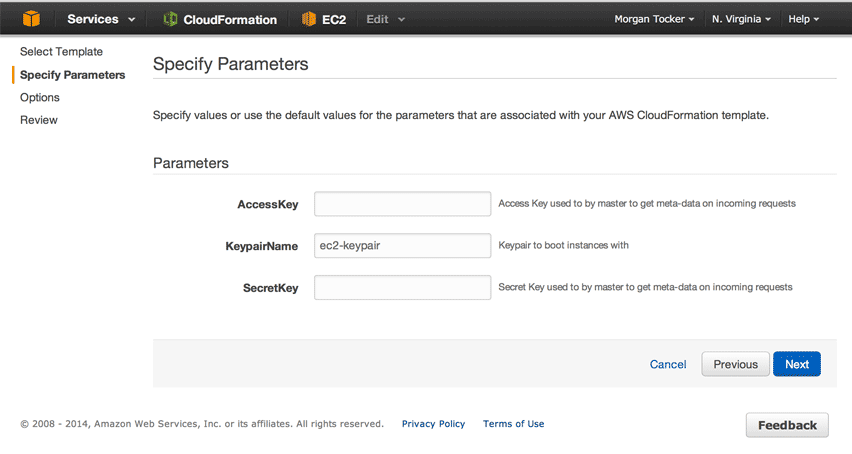Installing ‘mysql’ on Ubuntu 14.10 will default to version 5.5, but also included is MySQL 5.6 is an option.
These are the steps I ran through to install it on a fresh Digital Ocean droplet. On a local machine, you will need to add sudo:
root@ubuntu1410:~# apt-get install mysql-server-5.6
Reading package lists... Done
Building dependency tree
Reading state information... Done
The following packages were automatically installed and are no longer required:
linux-headers-3.16.0-21 linux-headers-3.16.0-21-generic linux-image-3.16.0-21-generic linux-image-extra-3.16.0-21-generic
Use 'apt-get autoremove' to remove them.
The following extra packages will be installed:
libaio1 libdbd-mysql-perl libdbi-perl libhtml-template-perl libmysqlclient18 libterm-readkey-perl mysql-client-5.6
mysql-client-core-5.6 mysql-common mysql-common-5.6 mysql-server-core-5.6
Suggested packages:
libclone-perl libmldbm-perl libnet-daemon-perl libsql-statement-perl libipc-sharedcache-perl mailx tinyca
The following NEW packages will be installed:
libaio1 libdbd-mysql-perl libdbi-perl libhtml-template-perl libmysqlclient18 libterm-readkey-perl mysql-client-5.6
mysql-client-core-5.6 mysql-common mysql-common-5.6 mysql-server-5.6 mysql-server-core-5.6
0 upgraded, 12 newly installed, 0 to remove and 3 not upgraded.
Need to get 21.8 MB of archives.
After this operation, 165 MB of additional disk space will be used.
Do you want to continue? [Y/n] Y
Get:1 http://mirrors.digitalocean.com/ubuntu/ utopic/main libaio1 amd64 0.3.110-1 [6,454 B]
Get:2 http://mirrors.digitalocean.com/ubuntu/ utopic-updates/main mysql-common all 5.5.41-0ubuntu0.14.10.1 [13.5 kB]
Get:3 http://mirrors.digitalocean.com/ubuntu/ utopic-updates/main libmysqlclient18 amd64 5.5.41-0ubuntu0.14.10.1 [603 kB]
Get:4 http://mirrors.digitalocean.com/ubuntu/ utopic/main libdbi-perl amd64 1.631-3build1 [770 kB]
Get:5 http://mirrors.digitalocean.com/ubuntu/ utopic/main libdbd-mysql-perl amd64 4.028-2 [88.6 kB]
Get:6 http://mirrors.digitalocean.com/ubuntu/ utopic/main libterm-readkey-perl amd64 2.32-1build1 [25.0 kB]
Get:7 http://mirrors.digitalocean.com/ubuntu/ utopic/universe mysql-client-core-5.6 amd64 5.6.19-1~exp1ubuntu2 [4,061 kB]
Get:8 http://mirrors.digitalocean.com/ubuntu/ utopic/universe mysql-client-5.6 amd64 5.6.19-1~exp1ubuntu2 [5,654 kB]
Get:9 http://mirrors.digitalocean.com/ubuntu/ utopic/universe mysql-server-core-5.6 amd64 5.6.19-1~exp1ubuntu2 [4,777 kB]
Get:10 http://mirrors.digitalocean.com/ubuntu/ utopic/universe mysql-server-5.6 amd64 5.6.19-1~exp1ubuntu2 [5,710 kB]
Get:11 http://mirrors.digitalocean.com/ubuntu/ utopic/main libhtml-template-perl all 2.95-1 [65.5 kB]
Get:12 http://mirrors.digitalocean.com/ubuntu/ utopic/universe mysql-common-5.6 all 5.6.19-1~exp1ubuntu2 [13.5 kB]
Fetched 21.8 MB in 4s (5,436 kB/s)
Preconfiguring packages ...
Selecting previously unselected package libaio1:amd64.
(Reading database ... 115597 files and directories currently installed.)
Preparing to unpack .../libaio1_0.3.110-1_amd64.deb ...
Unpacking libaio1:amd64 (0.3.110-1) ...
Selecting previously unselected package mysql-common.
Preparing to unpack .../mysql-common_5.5.41-0ubuntu0.14.10.1_all.deb ...
Unpacking mysql-common (5.5.41-0ubuntu0.14.10.1) ...
Selecting previously unselected package libmysqlclient18:amd64.
Preparing to unpack .../libmysqlclient18_5.5.41-0ubuntu0.14.10.1_amd64.deb ...
Unpacking libmysqlclient18:amd64 (5.5.41-0ubuntu0.14.10.1) ...
Selecting previously unselected package libdbi-perl.
Preparing to unpack .../libdbi-perl_1.631-3build1_amd64.deb ...
Unpacking libdbi-perl (1.631-3build1) ...
Selecting previously unselected package libdbd-mysql-perl.
Preparing to unpack .../libdbd-mysql-perl_4.028-2_amd64.deb ...
Unpacking libdbd-mysql-perl (4.028-2) ...
Selecting previously unselected package libterm-readkey-perl.
Preparing to unpack .../libterm-readkey-perl_2.32-1build1_amd64.deb ...
Unpacking libterm-readkey-perl (2.32-1build1) ...
Selecting previously unselected package mysql-client-core-5.6.
Preparing to unpack .../mysql-client-core-5.6_5.6.19-1~exp1ubuntu2_amd64.deb ...
Unpacking mysql-client-core-5.6 (5.6.19-1~exp1ubuntu2) ...
Selecting previously unselected package mysql-client-5.6.
Preparing to unpack .../mysql-client-5.6_5.6.19-1~exp1ubuntu2_amd64.deb ...
Unpacking mysql-client-5.6 (5.6.19-1~exp1ubuntu2) ...
Selecting previously unselected package mysql-server-core-5.6.
Preparing to unpack .../mysql-server-core-5.6_5.6.19-1~exp1ubuntu2_amd64.deb ...
Unpacking mysql-server-core-5.6 (5.6.19-1~exp1ubuntu2) ...
Processing triggers for man-db (2.7.0.2-2) ...
Setting up mysql-common (5.5.41-0ubuntu0.14.10.1) ...
Selecting previously unselected package mysql-server-5.6.
(Reading database ... 115966 files and directories currently installed.)
Preparing to unpack .../mysql-server-5.6_5.6.19-1~exp1ubuntu2_amd64.deb ...
Unpacking mysql-server-5.6 (5.6.19-1~exp1ubuntu2) ...
Selecting previously unselected package libhtml-template-perl.
Preparing to unpack .../libhtml-template-perl_2.95-1_all.deb ...
Unpacking libhtml-template-perl (2.95-1) ...
Selecting previously unselected package mysql-common-5.6.
Preparing to unpack .../mysql-common-5.6_5.6.19-1~exp1ubuntu2_all.deb ...
Unpacking mysql-common-5.6 (5.6.19-1~exp1ubuntu2) ...
Processing triggers for man-db (2.7.0.2-2) ...
Processing triggers for ureadahead (0.100.0-16) ...
Setting up libaio1:amd64 (0.3.110-1) ...
Setting up libmysqlclient18:amd64 (5.5.41-0ubuntu0.14.10.1) ...
Setting up libdbi-perl (1.631-3build1) ...
Setting up libdbd-mysql-perl (4.028-2) ...
Setting up libterm-readkey-perl (2.32-1build1) ...
Setting up mysql-client-core-5.6 (5.6.19-1~exp1ubuntu2) ...
Setting up mysql-client-5.6 (5.6.19-1~exp1ubuntu2) ...
Setting up mysql-server-core-5.6 (5.6.19-1~exp1ubuntu2) ...
Setting up mysql-server-5.6 (5.6.19-1~exp1ubuntu2) ...
2015-03-09 09:55:55 0 [Warning] Using unique option prefix key_buffer instead of key_buffer_size is deprecated and will be removed in a future release. Please use the full name instead.
2015-03-09 09:55:55 0 [Warning] TIMESTAMP with implicit DEFAULT value is deprecated. Please use --explicit_defaults_for_timestamp server option (see documentation for more details).
mysql start/running, process 19834
Setting up libhtml-template-perl (2.95-1) ...
Setting up mysql-common-5.6 (5.6.19-1~exp1ubuntu2) ...
Processing triggers for libc-bin (2.19-10ubuntu2.3) ...
Processing triggers for ureadahead (0.100.0-16) ...
Some additional notes:
- You will be prompted for a password for the root user. You can change it later, but best to think of something meaningful and write it down.
- The two WARNINGS that you see are quite safe. The default Ubuntu configuration uses a deprecated name for a configuration setting (Bug #1362393), and MySQL is warning that the behavior of TIMESTAMP columns may change in the future.
- The MySQL server should start automatically on boot. If you can not connect to MySQL, please check the file /var/log/messages. The most common reason it will not start is that the default configuration requires a server with 1GB of RAM. I have an you can use if you need it to start with less RAM.
